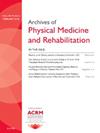Optimal Exercise Modalities and Doses for Alleviating Dyspnea Symptoms and Enhancing Exercise Capacity in Patients With Chronic Obstructive Pulmonary Disease: A Network and Dose-Response Meta-analysis
IF 3.7
2区 医学
Q1 REHABILITATION
Archives of physical medicine and rehabilitation
Pub Date : 2025-10-01
DOI:10.1016/j.apmr.2025.05.001
引用次数: 0
Abstract
Objective
To investigate the optimal exercise modalities and doses for alleviating dyspnea and enhancing exercise capacity in patients with chronic obstructive pulmonary disease (COPD).
Data Sources
PubMed, Cochrane, Embase, and Web of Science were searched until June 2024.
Study Selection
Randomized controlled trials on dyspnea and exercise capacity in patients with COPD were included.
Data Extraction
Exercises were compared using a network and dose-response meta-analysis. Two authors independently extracted the data and assessed bias risk.
Data Synthesis
The study included 46 randomized controlled trials (2363 participants). Continuous aerobic training (mean difference [MD]=55.2; 95% credible interval [CrI], 28.1-84.5; Grading of Recommendations Assessment, Development and Evaluation [GRADE]: Low), interval training (MD=84.5; 95% CrI, 24.6-145; GRADE: Low), Qigong (MD=33.3; 95% CrI, 10.4-58.1; GRADE: Low), and resistance training (MD=41.5; 95% CrI, 7.27-77.7; GRADE: Low) improved 6-minute walk distance (6MWD). Qigong (MD=−8.20; 95% CrI, −15.6 to −1.50; GRADE: Low) and yoga (MD=−28.3; 95% CrI, −48.1 to −8.61; GRADE: Low) showed significant improvements in St. George’s Respiratory Questionnaire (SGRQ). Resistance training (MD=12.1; 95% CrI, 4.62-18.7; GRADE: Low) correlated positively with forced expiratory volume in 1 second (FEV1), while Qigong correlated positively with forced vital capacity (FVC) (MD=0.378; 95% confidence interval, 0.087-0.620; GRADE: Low). Interval training, yoga, resistance training, and Qigong ranked the highest in 6MWD, SGRQ, FEV1, and FVC. The dose-response curve revealed an increasing trend in the effect of exercise intensity on enhancing 6MWD with intensified exercise levels. Regarding SGRQ scores, the optimal effect was observed at an exercise intensity of 620 metabolic equivalent of task (MET)-min/wk (MD=−7.07, 95% CrI, −12.23 to −1.87). The optimal exercise intensity was 350 MET-min/wk for FEV1 (MD=0.44, 95% CrI, 0.09-0.80) and FVC (MD=0.44, 95% CrI, 0.09-0.80).
Conclusions
Low quality evidence shows that interval training, yoga, resistance training, and Qigong effectively improved dyspnea and exercise capacity in patients with COPD. Optimal exercise doses vary across outcomes, necessitating personalized adjustments based on health status.
缓解慢性阻塞性肺疾病患者呼吸困难症状和增强运动能力的最佳运动方式和剂量:网络和剂量-反应meta分析
目的:探讨缓解慢性阻塞性肺疾病(COPD)患者呼吸困难和提高运动能力的最佳运动方式和剂量。数据来源:PubMed, Cochrane, Embase和Web of Science检索至2024年6月。研究选择:纳入COPD患者呼吸困难和运动能力的随机对照试验(RCTs)。数据提取:使用网络和剂量反应荟萃分析对练习进行比较。两位作者独立提取数据并评估偏倚风险。数据综合:该研究包括46项随机对照试验(2,363名参与者)。持续有氧训练(MD=55.2;95%显色指数:28.1,84.5。评分:低),间歇训练(MD=84.5;95%显色指数:24.6,145。等级:低)、气功(MD=33.3;95%CrI: 10.4, 58.1。等级:低)和阻力训练(MD=41.5;95%显色度:7.27,77.7。等级:低)改善6分钟步行距离(6MWD)。气功(MD = -8.20;95%CrI: -15.6, -1.50。等级:低)和瑜伽(MD=-28.3;95%CrI: -48.1, -8.61。评分:低)在圣乔治呼吸问卷(SGRQ)中有显著改善。阻力训练(MD=12.1;95%CrI: 4.62, 18.7。分级:低)与1秒用力呼气量(FEV1)呈正相关,气功与用力肺活量(FVC)呈正相关(MD=0.378;95%ci: 0.087, 0.620。等级:低)。间歇训练、瑜伽、阻力训练、气功在6MWD、SGRQ、FEV1、FVC中排名最高。剂量-反应曲线显示,随着运动强度的增加,运动强度对6MWD的影响呈增加趋势。SGRQ评分方面,运动强度为620 METs-min/week时效果最佳(MD=-7.07, 95% CrI: -12.23, -1.87)。FEV1 (MD=0.44, 95% CrI: 0.09, 0.80)和FVC (MD=0.44, 95% CrI: 0.09, 0.80)的最佳运动强度为350 METs-min/week。结论:低质量证据表明间歇训练、瑜伽、阻力训练和气功能有效改善COPD患者的呼吸困难和运动能力。最佳运动剂量因结果而异,需要根据健康状况进行个性化调整。
本文章由计算机程序翻译,如有差异,请以英文原文为准。
求助全文
约1分钟内获得全文
求助全文
来源期刊
CiteScore
6.20
自引率
4.70%
发文量
495
审稿时长
38 days
期刊介绍:
The Archives of Physical Medicine and Rehabilitation publishes original, peer-reviewed research and clinical reports on important trends and developments in physical medicine and rehabilitation and related fields. This international journal brings researchers and clinicians authoritative information on the therapeutic utilization of physical, behavioral and pharmaceutical agents in providing comprehensive care for individuals with chronic illness and disabilities.
Archives began publication in 1920, publishes monthly, and is the official journal of the American Congress of Rehabilitation Medicine. Its papers are cited more often than any other rehabilitation journal.

 求助内容:
求助内容: 应助结果提醒方式:
应助结果提醒方式:


